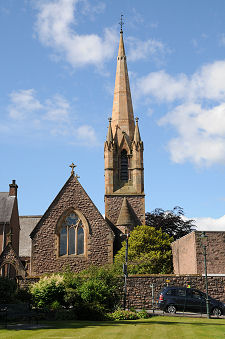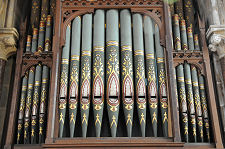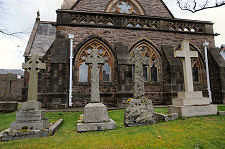 The Sanctuary |
Standing a little off to one side of Fort William's High Street towards its north-eastern end is St Andrew's Church. It is separated from the High Street by its churchyard, which is itself surrounded by a wall entered via a lychgate. St Andrew's is faced across the High Street by a parade of shops fronted by a covered walkway, and it is perhaps this, coupled with the fact that this part of the street has not been pedestrianised, that makes the church surprisingly easy to overlook.
Externally, St Andrews is pleasing to the eye, with the nave running parallel to the line of the High Street and its interestingly staged tower and spire. The main entrance is through a porch which projects forwards from the end of the nave, and once inside you find a fairly simple layout brought to life by beautiful detail. St Andrew's is a church that can only be fully appreciated if you take the time to explore the interior.
The internal layout is quite simple. The nave forms the main body of the church, while to its north-east end is the sanctuary, hidden externally behind the tower. At the south-west end of the nave is the baptistry, a fine space with more than an echo of a medieval chapel and a simply magnificent font.
St Andrew's is part of the Scottish Episcopal Church, a member of the world-wide Anglican Communion which traces its history back to St Columba and the early days of Christianity in Scotland. Like its sister-church south of the border, the Church of England, the Scottish Episcopal Church is governed by Bishops. This is one of the things that distinguishes it from the much larger Church of Scotland, a Presbyterian Church governed by representatives of the congregation.
This may not initially sound like a major difference, but it was King Charles I's efforts to impose government by Bishops on the Presbyterian Church of Scotland which led to a riot in St Giles' Cathedral in Edinburgh on Sunday 23 July 1637. This in turn led directly to the Bishops' Wars; the Wars of the Covenant; the English Civil War; the execution of Charles I; and Cromwell's occupation of Scotland: 23 years of wide-ranging conflict that did not really end until the restoration of Charles II in 1660. Those days are, thankfully, long gone, but it helps to know that differences of opinion about church governance were once, quite literally, a matter of life and death.
In the aftermath of the final defeat of the Jacobites at the Battle of Culloden in 1746, Episcopalians in the Highlands were often perceived to be supporters of the Jacobite cause, which led to their widespread suppression until 1792. It was 25 years later, in 1817, that the first Episcopal Church was erected in Fort William. The Rosse Chapel, named after the countess of Rosse, who had financed it, stood on the site now occupied by St Andrew's.
By the 1870s the chapel is recorded as being in a poor state or repair. It was a parishioner, George Baynton Davey, who paid for the chapel to be demolished and St Andrew's built in its place. The architect chosen was Alexander Ross of Inverness, better remembered for his work ten years earlier on Inverness Cathedral. St Andrew's was consecrated on 9 September 1880 by the Episcopalian Bishop of Argyll and the Isles, Dr. Mackarness.
The focal point of the church is the sanctuary, which is dominated by the altar, made from Caen stone like the font and the pulpit. The pillars featured within the arched design of the altar are made of Connemara marble. The bishop's seat on one side of the sanctuary is a reminder that the church was originally intended to serve as a cathedral, though this never happened. The choir stalls that line each side of the sanctuary are very striking: it is said that some 14th Century oak from Exeter Cathedral was used in their construction.
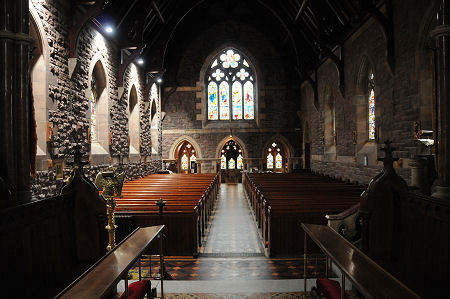 The Nave from the Sanctuary |
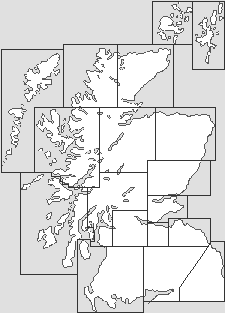
|
|
|
Visitor InformationView Location on MapGrid Ref: NN 103 740 What3Words Location: ///recover.beakers.peach |
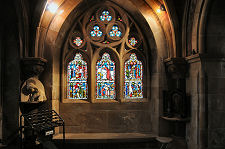 Baptistry Window |
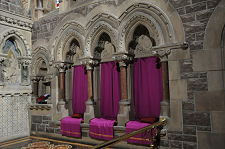 Seats in the Sanctuary |
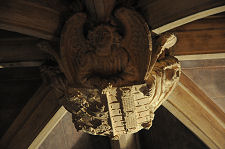 Ceiling Boss |
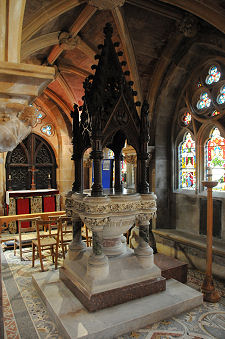 The Font in the Baptistry |
